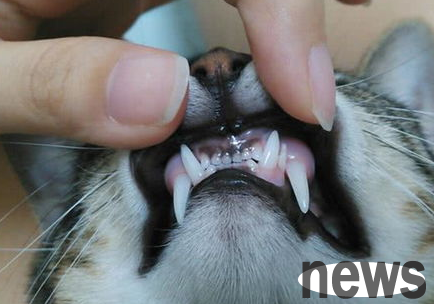In fact, cats and dogs are similar to humans. They have no teeth when they are born, because they still need breast milk to feed them at the beginning. If so many cats suck with their teeth when they are feeding them, how can they not stand it? It is simply another difficulty after giving birth.
Usually, when the kitten is 3-4 weeks, the breast teeth will slowly grow. Until 7 weeks later, due to the pain caused by the teeth, the female cat will slowly stop feeding the kitten. This is also the best food change period, so that they can start to learn to chew food.
The kitten has not big teeth and looks a little transparent

So, when will you start changing teeth?
When the deciduous teeth are 3-6 months old, their roots begin to undergo dissolution and shorten until they become inconspicuous breaks under the crown. So if you find that the kitten spits out white teeth (maybe bloody) at this time, don’t be surprised. This is to change the teeth, and you have to change more than 20!
And the baby teeth are soft at this time, even if they are accidentally eaten by cats during the teeth change process, they can be digested by the stomach and intestines.
In addition, during teeth replacement, you can also find that cats will have some abnormalities because teething will irritate the gums, and the cat will hope to relieve it through other behaviors.
Beginning to grind teeth, especially shoes, furniture and some bedding, will become their targets;
drooling constantly, and the roots of the deciduous teeth begin to dissolve due to the compression of permanent teeth;
Frequently licking the paws with your mouth, or rubbing other things with your face;
In the state of very strong pain, it will even refuse to eat;
Once you find these signs, you can give it some soft things to help it grind teeth, or soak the food to make it easier to eat.
However, there are two other situations during the process of changing teeth, and we need to be vigilant. One is that the baby teeth have not fallen off, but the constant pressure has grown, which will cause various oral problems. It is best to find a doctor to remove the baby teeth; the other is gingivitis during puberty. Although the specific cause is not very certain, some people have proposed hypothesis that it may be that the immunity in adolescence has a brief decline, accompanied by tooth replacement stimulation, resulting in infection.

What is gingivitis during puberty?
Adolescent gingivitis is very similar to gingivitis in adult cats, both of which are inflammation due to irritation and infection. The difference is that gingivitis during adolescence usually occurs after a kitten has changed teeth. Especially the Maine cat, Siamese cat, Persian cat and other breeds are very easy to appear. As mentioned earlier, gingivitis during adolescence is caused by a decrease in immunity, so long-term patient care is required before the immune system stabilizes, and it is not a problem that can be solved by just anti-inflammatory drugs like gingivitis.
During the treatment period, follow the doctor's instructions to do some basic home care and anesthesia and teeth cleaning. You can recover from about 1 year old. In severe cases, it will be delayed until about 2 years old.
The high incidence of gingivitis in adolescence is near the molars. It can be found that it is about 7-10 months old. If you do not treat it for a long time, it is easy to develop periodontal disease or even cat stomatitis. In this case, the best solution is to remove excess gums and wash teeth to avoid redness, swollen and hyperplasia of gums, and breed plaque and tartars.
In the subsequent treatment, interferon can be used to regulate immunity, and try to minimize stimulation of gingival tissue and immune system to prevent recurrence. What you need to mention during this process is daily brushing. If the cat really doesn’t like it, in addition to teeth cleaning, you can also try pet mouthwash, chlorhexidine gel, lysozyme gel, etc.
